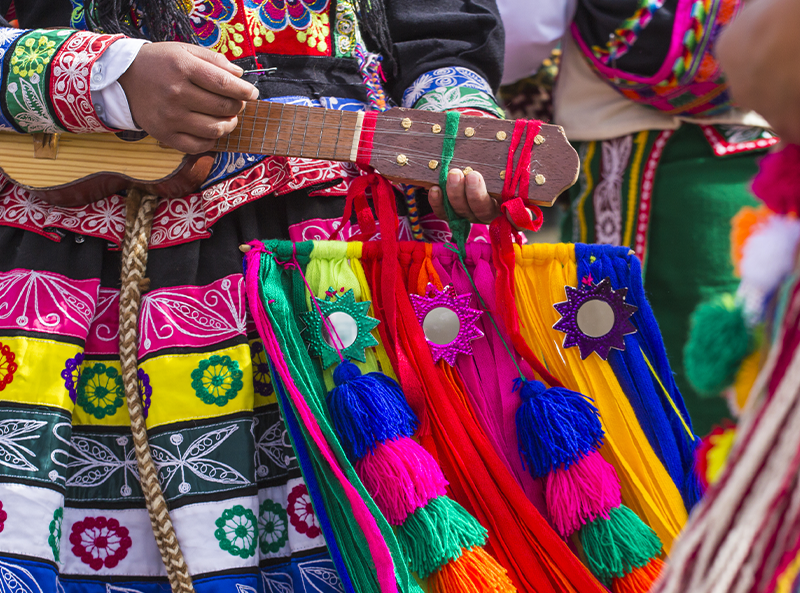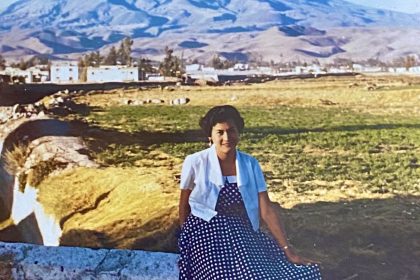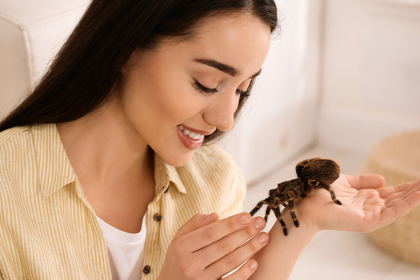How Cultures Protect the Environment
Hola Chicas!
And Wow! We are in May with all its celebrations and excitement. Everything from holidays to graduations to mindfulness and getting down to business. May begins Mental Health Awareness, which seems to be a perfect time to check in almost half way through the year. Take some time to reframe your workload, assess how you are feeling and plan how to address this during the month. Maybe a good lead up to Summer vacation or maybe realizing you need some extra help with kids off school.
This week is also National Small Business Week celebrating the tenacity of entrepreneurs and Founders. If anyone is running their own small business, then you probably agree with celebrating this week in Mental Health Awareness month. Congratulations to all the badass chicas out there, across the Globe, passionately engaged in what they love and how they want to live life.
As I mentioned in the last episode, we are focusing on Mothers this month, from our own Queens to Mother Earth. Today’s episode highlights how our cultural identity impacts the environment and celebrates women who have always been resourceful with what they have, reusing things in a multitude of different ways and ultimately not contributing to landfills.
People outside the culture view this resourcefulness as a sign of low income, hoarding or ignorance. But, we know better. We learned it from our grandmothers and mothers and will pass it on to our own grandchildren and nieces. You know who I’m talking about. The women who never take anything for granted and have been saving Mother Earth for millennia.
It made us laugh as kids, maybe be a tad embarrassed but as we get older, we realize they are brilliant. It still makes us laugh though how nothing gets thrown out, not even plastic bags. Everything from cookie tins to broken dishes to gifted wrapping paper are used for other purposes.
Cultural Identity Impact on the Environment
I used to think everyone did this because the resourcefulness was so clever. Honestly, it is only recently that I realized each culture has their own version of being resourceful. The Latina culture is really specific on how items get reused so it becomes part of identity in a broad sense.
Identity also revolves around fashion, from the roots of cultural identity to current day self expression. Very much in sisterhood with the Black community. Some items are so iconic, like gold hoops and bold color, that it doesn’t matter what else we are wearing, those are part of the look.
Still, the pressure to be on brand or create a self-look can make it difficult to be resourceful. Add the pressure of career and family and the valuable time we used to have to make our things has all but disappeared.
But why is this so important when we have so much available at our fingertips. We can have things delivered to our door in a matter of days, for cheap. That’s where the problem lies – “fast fashion”.
Around the world, the biggest contributors to our trash landfills are the fashion and cosmetic industries. For as much as we love our look, and we do love our sassy look!, there’s a reason we were taught to resource our clothing or make it ourselves from good materials.
But how can we create our look without contributing to the problem? How much of an impact can we make by some small changes? And of course, our Reinas, what have we learned from our mothers that still apply today in resourcing our clothing?
While you’re pondering that a moment, I am going to give you the last little hints for this week’s steamy cafecito moment. Did you pick up on that hashtag, #steamy cafecito, in the Instagram stories?
Cafecito Shout Out
For those of you new to the podcast, so much gratitude for joining in. I really appreciate you joining the community. Here’s a little heads up on our cafecito moment. We take the time each week to visit a diverse-owned coffee business to support their entrepreneurial spirit and financial gain through our favorite ritual of coffee.
This week’s business is new, a bebe just last year and a black woman owned business in Oakland, California. Their specialty is roasting their own coffees that they sell in 2 locations but also online. The founders, Jenna Garrett & Justice Chambers, have a powerful mission statement for their business that will have you grabbing a cup and standing up in solidarity.
I will tell you more about the amazing cafe towards the end of the podcast so stay tuned!
How Fashion Is Culturally Based
So, let’s get into today’s topic of how our cultural identity impacts the environment. We don’t have to go too far back to know someone who actually wove their own textiles, starting from making the yarn or threads from local sources. These practices go back to Native people and fortunately have been preserved through generations.
Creating textiles has two social elements to it: one, to support the family with clothing or income and two, a status statement. Masters of the process created a higher quality of fabric, and most likely, a more complex design and with that, social recognition.
Native people used different colors, textiles and styles to identify themselves within tribes. Even families within tribes had a definable design all their own. Each elder generation taught the next generation the process and also passed down their identifiable design for the family. It was an honor to learn the knowledge of the elders.
Travelers, even a generation ago, were blessed with seeing locals in their handmade customary clothing throughout the world. There was a strong cultural identity, focused on the detail of each area. And although the native clothing is still worn in places, it is often alongside a Western influence of jeans and T-shirts.
In the countries of our parents, clothes were handmade at home or from the local tailor. Same with shoes. Regardless of financial status, our recent generations of family had access to gorgeous clothing, resourcefully crafted and treasured for its quality.
As the global economy skyrocketed, then textiles and fashion became cheaper and mass produced to the point of being disposable. Now, we are in a state of Fast Fashion where as soon as a trend is born, it is outdated and useless.
What Is Fast Fashion
It’s so tempting. I get it. Fast fashion is constantly at our fingertips. We all love scrolling through online stores and those Instagram ads, but do we ever consider where those sassy fashions are made? Or, do we stop to consider if we really need that cuteness?
Especially when our activities and events are posted up all over social media. After all, there are brunches, shopping trips, and casual meetups. Dare you show up in the same outfit more than once? And if the answer is no way, then that’s cool but does it have to be new?
Fast Fashion is a really recent phenomena that came from the marriage of global demand and technology. When technology developed e-commerce, then this became a marriage whose children would cause immense destruction. Since companies no longer needed one on one communication with customers, interference from time zones or monetary exchange differences were eliminated.
This is the problem. Fast fashion comes from the demand of buyers wanting basically disposable clothing so there’s no pain in using it once for that “special scene”. It’s inexpensive so we feel flush to buy often and in bulk.
Unlike our ancestors, companies have no interest in pride of product or cultural identity. They produce, even over-produce, because the cheap process is readily compensated by the huge profit margins.
So, there’s no one paying attention to what’s happening. And what’s happening, you ask? We are dumping, literally dumping, this fast fashion into the natural environment. The products are so toxic that they aren’t allowed in the landfills so they are dumped in public lands where no one is watching.
Why Fast Fashion Is Bad for the Environment
Wicked, right? We want to believe that everyone is doing right by each other and by the environment. It’s not our responsibility to understand what the materials are made of or if it’s toxic. But, actually it is. It is our responsibility.
Fast fashion is really bad for the environment because the fabric is cheap, not in the sense of inexpensive, but cheap quality. In fact, it is full of micro plastics which are finding their way into our food, especially seafood. Today, scientists say they are discovering micro plastics in humans through our food cycle.
Unfortunately, the countries that tended to take on the mass production don’t follow regulations to protect the environment. So production goes on 24/7, using fossil fuels and dumping waste into waterways and the air. And as we now know, that pollution is global just by how the world works.
Delivery also adds mass amounts of pollution as shipping across the world increases air traffic. Add in Amazon delivery trucks and woof! Pollution has exploded. The problem doesn’t end when it arrives to the buyers though.
You see, given the inexpensive clothing, all the opportunities to be “seen” in a great outfit, especially on social media, most buyers have already accepted the idea that their purchase is short-lived. Fashionistas are dumping 85% of their clothing into landfill. 85% Just to keep up with trends. So where does all this mass clothing buying and dumping go? To foreign countries that contract with the fashion industry to accept their waste.
This actually hits a very personal note that just devastates me. Because one of these mass clothing dumps has found its way into Chile. Not just the country, but the pristine, one of a kind, Atacama Desert, which also extends into southern Peru.
Fast Fashion Garbage Dumps
Now, you may be thinking the desert is the perfect place for us to put our trash. There’s few people there and it rarely rains. The Atacama desert actually sees only 1/2” of rain a year. It is the driest place on Earth with barely any species that can survive it.
Which is crazy because this is where my father, Jo, was sent to be a geophysicist for Newmont mining company from Canada. A little background here, this is the base for the most epic love story that I have ever heard. Not because these are my parents but because of the sacrifice and determination to get to your loved one.
So, this was Jo’s first job out of college. The boy from Wyoming left the University of Utah, got on a plane, or a few planes, in 1954, and landed in Arequipa, Peru. He didn’t speak a word of Castellano but had been in the Korean War so at least had been in a foreign country before.
Within days, he met my mother, who worked at the British Embassy, spoke the Queen’s English and had never seen turquoise colored eyes before. They fell head over heels in love instantly.
But my dad was sent out with the mining team to live in a cave in the Atacama Desert. They were so far out of town that there was no access into the City. Well, that was too long to wait for my father. He wanted to be with his Consuelo!
So, what did he do? He figured out when the moon would be full and out after dark. He used the distant City lights as a beacon. And he began to walk, 16 miles alone, across the driest desert in the world, at night with only a tin canteen and his conviction to see my mother.
Where to Start Over in Fashion
What if my dad were trying to get to my mom today? What if he was crossing the desert at night only to come upon a huge mountain of clothing, got turned around and could no longer see the City lights beckoning him in the distance?
Fast fashion is the demise of our love story with Mother Earth. A love story nurtured and cared for by our ancestors and now it’s up to us to rekindle the love. We know how. It’s in our DNA, in our families and cultures and in our desire to live our identity out loud.
Think of all the beautiful textiles that come from your culture. Feel the pride and appreciation for the expertise and immense talent that has been pulsing through generations and generations of families. Families continue to sustain themselves financially by creating small businesses to sell their products, even globally, but still handmade.
Fortunately, as awareness of the toxic fast fashion rises so does the passion for returning to the basics. Entrepreneurs are bringing back the ideal of handmade clothing in native materials and fashion to encourage cultural identity. It is the perfect chance to avoid blending in and striking that unique look.
Entrepreneurs are a blessing because they see the answer to a growing problem and readily address it. Small businesses – and just so you know, small business is defined in the U.S. as having less than 500 employees – Currently, 42% of small, not so small, businesses are owned by women and of those, 50% are owned by women of color.
Further, according to the recent Bureau of Labor report last year, 89% of new women-owned businesses are by women of color. Badass chicas! All these businesses are generating almost $2 trillion dollars annually.
Resourcing is an Alternative to Fast Fashion
So, let’s roll through some ideas for reversing Fast Fashion and going back to the sustainable quality of our generational families. Let’s try the easier route first before you take on weaving your own fabrics.
First off, try encouraging your mom to let go of some of her iconic pieces. Our mamas are a source of sass and if they have kept their pieces from 20 or 30 years ago, woohoo!, you are in for a treat! Of course, this may be the most difficult place to start, too. You mother may not be ready to let go of her treasures.
I kept begging my mom to let me have some of her dresses when I was a teenager. Then again, when I was in my 20’s, then 30’s… I never got them. Instead, she gave them to my daughter! I don’t overanalyze that move very much and yet, it sticks with me to this day.
Secondly, there’s always second hand stores both in your local areas and online. Brick and mortar stores may be more tricky in finding your style and size due to space limitation. Online options tend to have more selection and affordability. Ones like ThredUp, Poshmark and Tradesy.
Now, if resourced clothing isn’t your thing, I get it. Let’s focus on the new.
If you are blessed to have your mother and grandmother, ask if they know how to make their own clothes or accessories. Better yet, ask them to teach you. Even if you aren’t ready to don a handmade outfit yourself, you can learn for when you or your friends have children. It’s never too soon to start reversing the cycle of fast fashion.
Or support stores that are women owned, especially owned by women of color, who want to be a part of the healing solution for fast fashion. Look for stores that offer sustainable fabrics, locally sourced materials or handmade fashion. When you seek out these businesses, you are not only creating your unique identity, you are contributing to their family’s financial well-being.
Show Us Your Cafecito Moments!
Woo! I love coming around on a high note!
Now, for the cafecito moments. I hope you were following the hints on our Instagram Stories. If you missed them, remember to find them in our highlights on our profile. We made a reel of last week’s steamy cafecito at the Wooden Table so you can check that out on our Instagram profile at Life Lnxx.
Now, I had been trying to get to this week’s cafecito business for awhile but our schedules just weren’t jiving. I’m so happy that we finally made it happen and on a gloriously warm, sunny day. Fortunately, I landed near the end of the business day so I had time to listen to Jenna’s story of taking a chance on herself.
Jenna Garrett and Justice Chambers founded Soul Blends Coffee Roasters just last year, a BIPOC owned specialty coffee service in Oakland, California. It’s literally their one year anniversary this week so a huge congratulations on persevering through all the struggles and landing in joy and value amongst the community.
Their mission statement is a powerful testament to human connection, something I emphasize often on this podcast. It focuses on turning a daily ritual of our cafecito into a means of broadening cultural experience and giving back to the surrounding communities. Jenna’s innate compassion spills into each cup she crafts as you delicately sip yourself into calm.
Not something I expected from my second latte of the day but that Moroccan Spiced latte sent me to another place where I just wanted to linger and be grateful. Truly a blessing!
Soul Blends coffee is sourced in Africa with multiple varieties to choose from. If you are not in the area, the coffee can be purchased online at mysoulblends.com in 12oz or 2lb bags, whole bean to ground.
Ciao!
You can also access it in this episode’s transcript on our website at TheLnxx.com. So please support this business as they continue to grow and develop relationships throughout their community.
Check out the cafecito highlights on our Life Lnxx Instagram for more visuals of this inviting outdoor cafe with Jenna crafting sensual coffee with so much good feeling. Remember to tag Life Lnxx in your favorite cafecito moments or in your newly resourced outfits. I can’t wait to see how clever you are, how beautifully you identify yourself and the smiles knowing that you are caring for our Mother Earth.
Take a look on our website at TheLnxx.com for each episode’s transcripts and the articles linked to what you’ve heard here today.
Share the love of this podcast with your friends and leave a review for us on Apple Podcasts so we can stay in conversation.
Step into your truth, ladies. We love you! Ciao!
[Outro]




